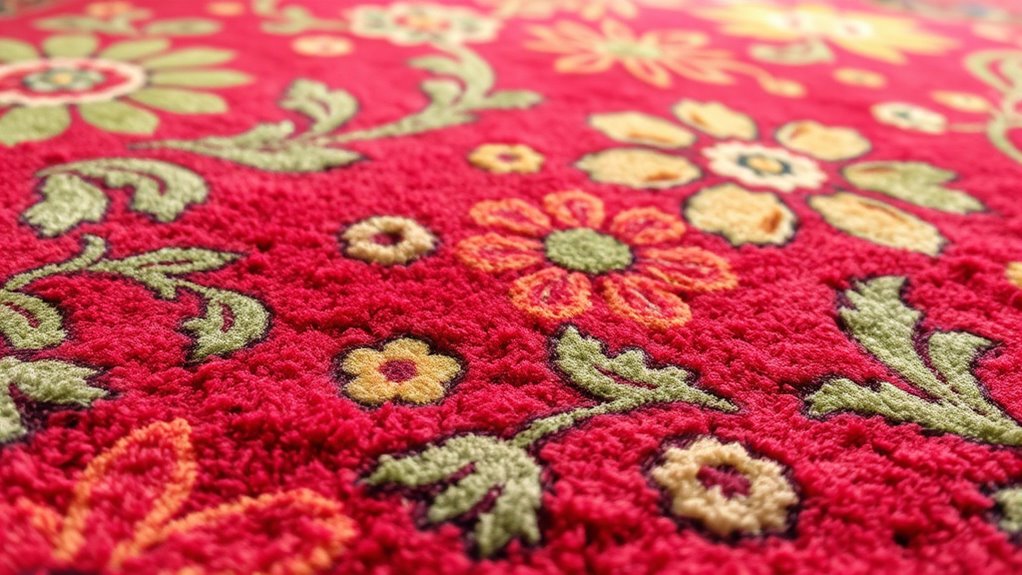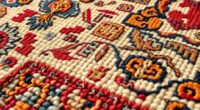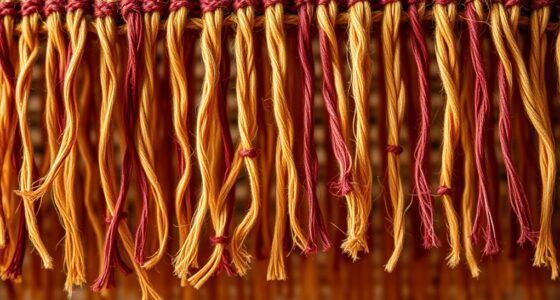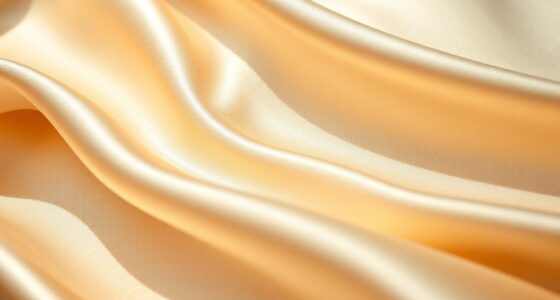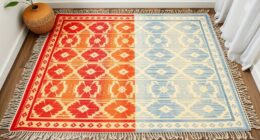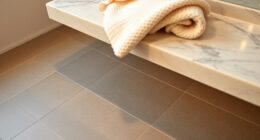Many believe that sunlight immediately ruins vegetable-dyed carpets, but that’s a misconception. In reality, UV exposure causes gradual fading over time rather than instant damage. Properly woven and cared-for natural dyes often resist sunlight longer than you might think. The key is understanding how factors like light intensity and fiber type influence color preservation. Keep exploring to discover effective ways to protect your rug and keep its beauty enduring.
Key Takeaways
- Moderate sunlight can enhance vegetable dyes, creating a natural patina rather than immediate fading.
- UV exposure accelerates fading but does not cause rapid or irreversible damage if managed properly.
- Proper placement and protective measures can significantly prolong the colorfastness of vegetable-dyed carpets.
- Myths suggesting sunlight instantly destroys vegetable dyes are exaggerated; natural dyes are generally UV-resistant.
- Controlled sunlight exposure may preserve or even highlight the carpet’s vibrant hues over time.
Understanding Vegetable Dyes and Their Composition
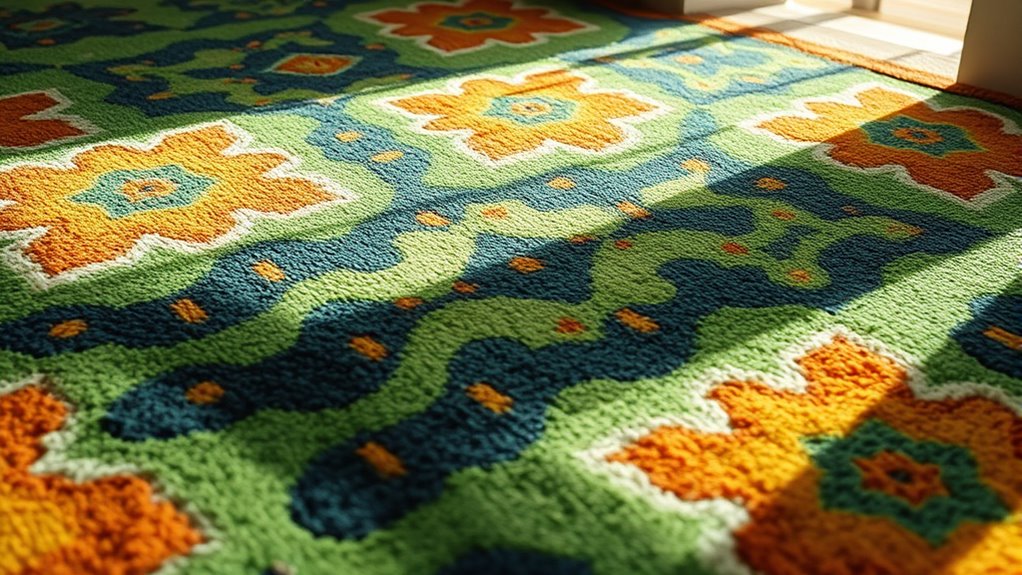
Vegetable dyes are natural pigments extracted from plants, roots, bark, and fruits, making them a popular choice for eco-friendly and traditional dyeing methods. These plant pigments are obtained through dye extraction, a process that isolates the color compounds from plant materials. When you work with vegetable dyes, you’re harnessing centuries-old techniques that emphasize sustainability and minimal chemical use. The dye extraction process involves soaking, boiling, or fermenting plant parts to release vibrant pigments. These natural dyes are valued for their unique hues and biodegradability. Unlike synthetic dyes, vegetable dyes often have variations in color, which add depth and character to textiles. Understanding the composition of vegetable dyes helps you appreciate their beauty and the careful processes involved in creating eco-conscious, vibrant colors for your projects. Additionally, knowledge of fiber compatibility is essential for ensuring that the dye bonds well with different textiles, enhancing durability and colorfastness over time. Recognizing the factors that influence colorfastness can help in achieving longer-lasting results and better overall dye performance.
The Science Behind UV Light and Color Fading
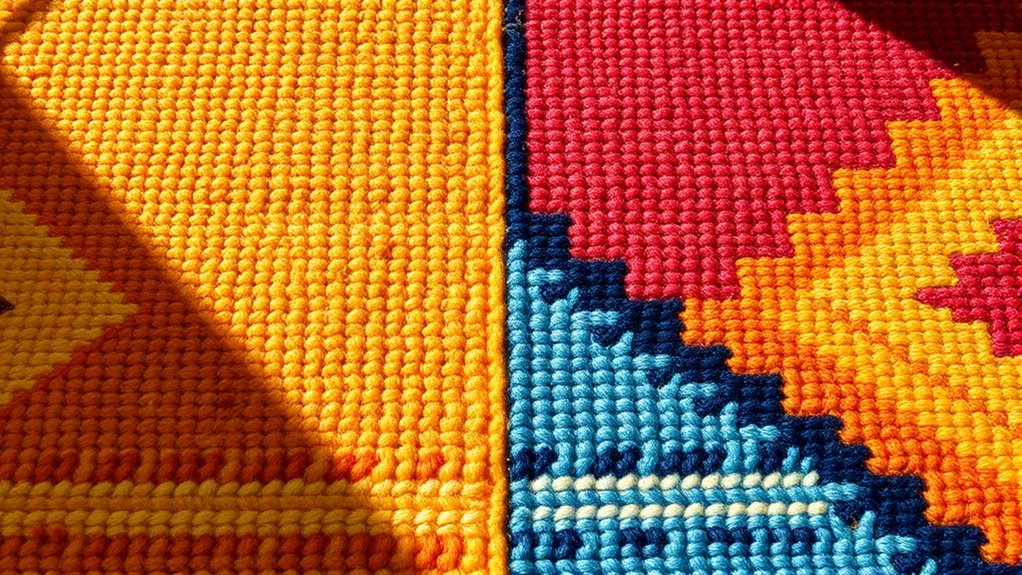
UV light covers a specific part of the electromagnetic spectrum that interacts with colors in unique ways. Your understanding of how chemical compositions respond to UV exposure reveals why some materials fade faster than others. Environmental factors like temperature and humidity also play a vital role in accelerating or slowing down this process. Additionally, the role of attention during exposure can influence the extent of fading, as focused or prolonged exposure may intensify the effects. Recognizing chemical reactions involved in dye degradation helps explain the variability in fading patterns among different vegetable-dyed carpets. Moreover, the material’s composition significantly impacts its susceptibility to UV-induced fading, with natural dyes often reacting differently than synthetic alternatives. Research indicates that UV stability varies considerably among different dyes, influencing their durability over time.
UV Light Spectrum
Have you ever wondered how different wavelengths of light affect colors? The UV spectrum, a small part of sunlight, plays a significant role in color fading. When your carpet is exposed to light, the UV rays penetrate the fibers, breaking down dye molecules over time. This process depends on the light exposure duration and intensity. UV rays are divided into UVA, UVB, and UVC, with UVA being the most common in natural sunlight reaching the Earth’s surface. Each wavelength interacts differently with dyes, with shorter wavelengths often causing more damage. Understanding the UV spectrum helps explain why prolonged exposure accelerates fading. It’s not just sunlight, but specific UV rays that influence how colors fade, emphasizing the importance of controlling UV exposure to preserve vibrant dyes. Additionally, the nature of dye molecules and their chemical composition can affect their susceptibility to UV-induced fading. Recognizing UV light’s impact on materials can aid in developing better protection strategies for dyed textiles. Since the market growth in UV-protective coatings is expanding, it highlights the increasing importance of such technologies in preserving color integrity. Moreover, advancements in material science contribute to creating more effective UV-blocking solutions to extend the life of colored fabrics. A deeper understanding of UV light interactions with dyes helps in designing textiles that resist fading for longer periods.
Chemical Composition Effects
The chemical makeup of dyes and fibers considerably influences how they respond to UV exposure. Your dye chemical determines its stability; some vegetable dyes have complex structures that resist breakdown, while others fade quickly. The fiber interaction also plays a pivotal role—natural fibers like wool and cotton often absorb dyes differently than synthetic fibers, affecting their vulnerability to UV damage. When UV light hits the carpet, it can break down the chemical bonds within the dye molecules, causing fading. However, the specific dye chemical structure can either resist or accelerate this process. Additionally, how the dye bonds with the fiber influences whether UV exposure causes superficial fading or deeper discoloration. Understanding these chemical interactions helps explain why some carpets fade faster than others under UV light.
Environmental Factors Influence
Environmental factors such as temperature, humidity, and light exposure considerably influence how quickly and severely colors fade when carpets are subjected to UV radiation. These conditions affect dye stability and the rate of dye extraction, impacting the longevity of vegetable-dyed carpets. High temperatures can accelerate chemical reactions, speeding up dye breakdown, while humidity promotes mold and deterioration. Light exposure, especially UV rays, causes molecules to break apart, leading to fading. Eco-friendly processes in dyeing can help improve colorfastness, but environmental factors still play a critical role. To visualize this, consider:
- Intense sunlight increasing UV radiation’s effect
- Fluctuating temperatures causing expansion and contraction
- Elevated humidity promoting microbial activity
- Properly sealed carpets resisting dye extraction
- Use of natural, eco-friendly dyes that resist fading
- Environmental conditions significantly impact dye longevity and color retention. Additionally, dye stability can be compromised by environmental stressors, emphasizing the importance of proper maintenance and storage. Regular cleaning and appropriate storage conditions can help preserve color vibrancy over time.
Common Misconceptions About Sunlight and Carpet Damage

Many believe that sunlight always causes carpet fading, but that’s not entirely true. Some natural dyes resist UV damage better than others, showing that sunlight’s effects vary. Understanding this variability helps you protect your carpets more effectively. Additionally, the use of carpet protection tips can further minimize fading caused by various environmental factors.
Sunlight Doesn’t Always Fade
While sunlight can cause fading, it doesn’t always harm carpets equally. Many believe that any exposure leads to quick deterioration, but that’s not the case. Indoor lighting, especially when equipped with UV protection, can markedly reduce fading risks. Carpets in shaded areas or rooms with window treatments often stay vibrant longer. Factors like fiber type, dye stability, and even carpet placement influence fading. For example, a well-protected, vegetable-dyed carpet might resist fading despite sunlight exposure. Conversely, carpets in direct sunlight with poor UV protection will fade faster. It’s essential to understand that not all sunlight causes damage—proper window treatments and indoor lighting choices can help preserve your carpet’s color. Fading depends on multiple factors, not just sunlight exposure alone.
Natural Dye Resilience Explained
Contrary to popular belief, natural dyes often withstand sunlight better than synthetic ones, challenging the idea that all dyes fade quickly under exposure. Natural dyes, especially those derived from vegetables, tend to have enhanced UV protection due to their complex chemical structures, which contribute to greater dye longevity. This resilience means your vegetable-dyed carpets can maintain their vibrant colors longer when exposed to sunlight. The misconception that sunlight instantly ruins natural dyes overlooks their actual durability, especially when properly woven and treated. While UV exposure can weaken dyes over time, natural pigments often resist fading better than synthetic alternatives. Understanding this helps you appreciate the true resilience of vegetable dyes and reassures you that your carpet’s colors can last for years with proper care.
Variability in UV Effects
Sunlight’s impact on your carpet varies depending on several factors, making it a common misconception that all exposure leads to immediate damage. The degree of UV fading depends on factors like fiber type, dye quality, and exposure duration. Some carpets have better colorfastness variations, resisting fading longer than others. Others benefit from dye renewal techniques that restore vibrancy over time.
Consider these elements:
- Fiber composition influences fade resistance
- UV intensity varies by location and season
- Age of the carpet affects dye stability
- Protective coatings can mitigate fading
- Use of specific dyes impacts color retention
Understanding these variables helps you realize that not all sunlight exposure results in rapid deterioration. Proper maintenance and treatment can prolong your carpet’s vibrant appearance despite UV exposure.
How Different Sunlight Intensities Affect Dyes
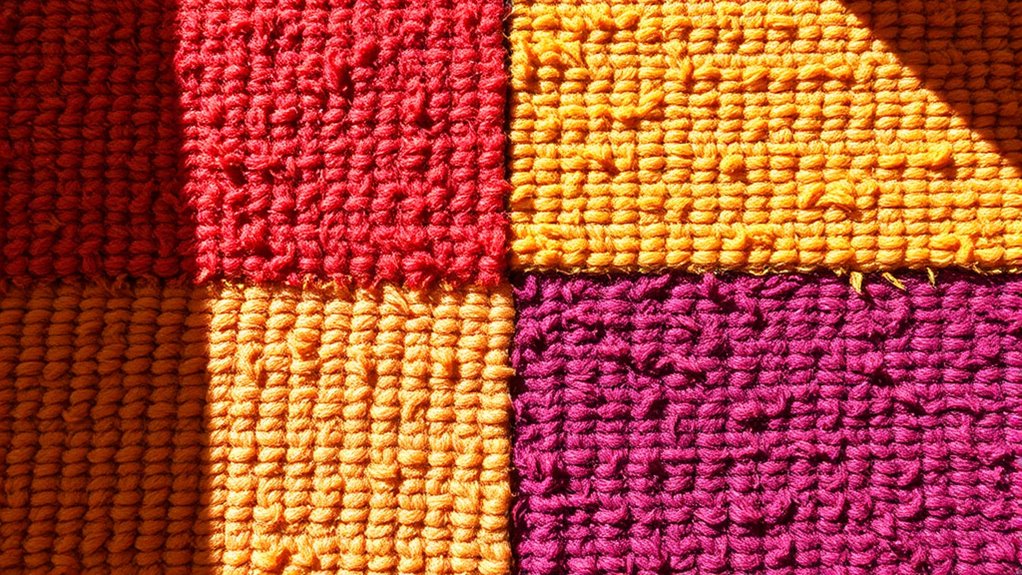
Different intensities of sunlight can have a significant impact on how quickly dyes fade. Higher sunlight intensity accelerates dye degradation, leading to faster color loss. Intense UV rays cause fiber degradation, weakening fibers and making colors more vulnerable. Conversely, lower sunlight levels mean slower fading and better dye retention over time.
| Sunlight Intensity | Effect on Dyes |
|---|---|
| High | Rapid fading, fiber damage |
| Moderate | Gradual fading |
| Low | Minimal fading, fiber preservation |
| Very Low | Dyes remain vibrant longer |
In bright sunlight, UV radiation intensifies fiber degradation, speeding up dye fading. Understanding how sunlight intensity impacts your textiles helps you protect your carpets and preserve their color for years.
The Role of Fabric and Fiber Types in Color Retention
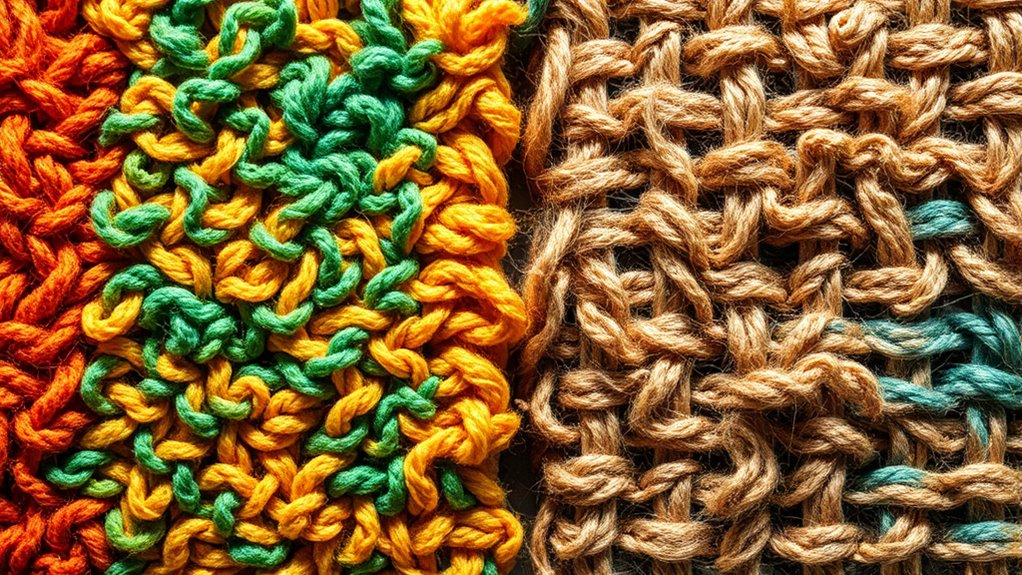
The type of fabric and fiber markedly influence how well colors stay vibrant over time. Different fibers vary in fabric durability and dye penetration, which impact color retention. Natural fibers like wool and silk often hold dyes better, offering richer, longer-lasting hues. Synthetic fibers such as nylon and polyester may resist fading but can be less receptive to dye penetration, affecting overall vibrancy. Factors like fiber porosity determine how deeply dyes embed, influencing UV resistance. The structure of the fabric also matters; tightly woven textiles tend to protect dyes from UV exposure. Understanding these differences helps you choose materials that preserve color longer. Keep in mind, fiber composition and weave density are key to maintaining the beauty of vegetable-dyed carpets over years of exposure.
Natural vs. Synthetic Dye Stability Under UV Exposure
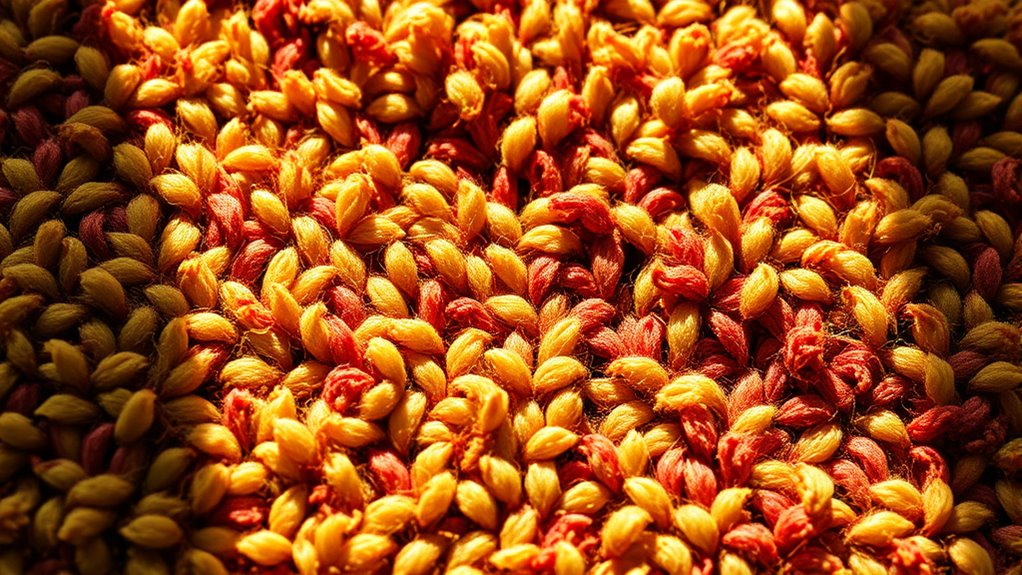
You might assume natural dyes resist fading better under UV exposure, but that’s not always the case. Synthetic dyes often have enhanced light stability, making them more resistant to UV damage over time. Understanding these differences helps you choose the right dye for lasting color.
Natural Dyes’ UV Resistance
While natural dyes are often praised for their eco-friendly origins, their resistance to UV exposure varies markedly compared to synthetic dyes. UV damage can affect natural dyes differently, impacting dye stability over time. You might notice fading or color changes after prolonged sunlight exposure, especially if the dye isn’t properly treated. Factors influencing UV resistance include the type of plant pigment, mordants used, and dyeing techniques. To help you visualize, consider:
- Vibrant, earthy hues gradually fading with sun exposure
- Uneven fading where sunlight hits directly
- Colors shifting toward duller or more muted tones
- Increased vulnerability in lighter shades
- Natural dyes losing vibrancy faster than synthetics under UV rays
Understanding these factors helps you appreciate the nuances of natural dye longevity and UV resilience.
Synthetic Dyes’ Light Stability
Synthetic dyes generally demonstrate greater stability under UV exposure compared to natural dyes, making them more resistant to fading from sunlight. This enhanced color fastness means your carpets maintain their vibrant appearance longer when exposed to light. Synthetic dyes are formulated for improved dye durability, ensuring they resist the breakdown caused by UV rays. While natural dyes can fade over time, especially under direct sunlight, synthetic options typically offer consistent color retention. This makes synthetic dyes a practical choice for areas with high light exposure or for those seeking long-lasting vibrancy. Keep in mind, though, that not all synthetic dyes are equal, and some may still fade if exposed to intense or prolonged UV radiation. Overall, synthetic dyes provide superior light stability and extended dye durability.
Tips for Protecting Vegetable-Dyed Carpets From Fading
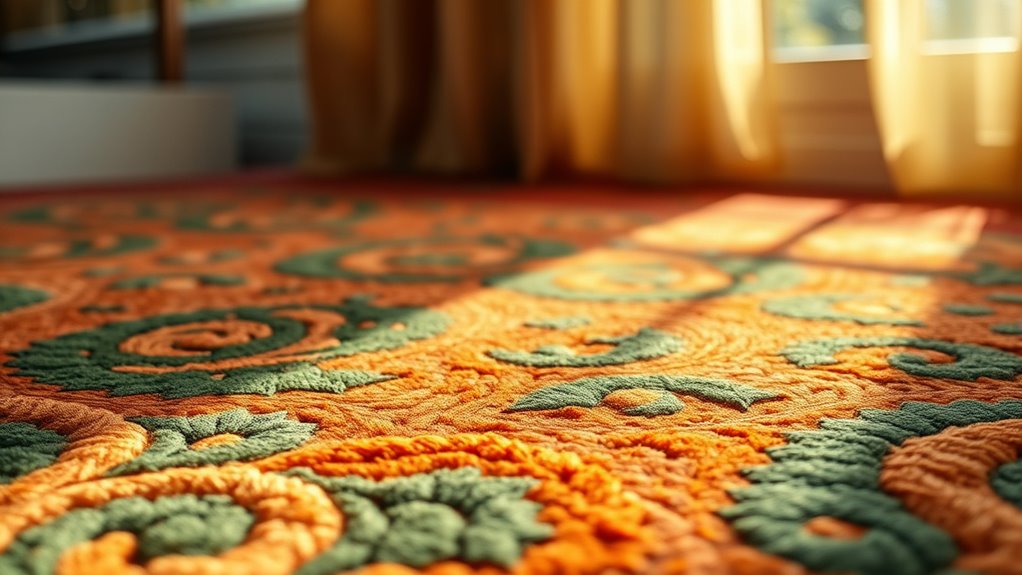
Protecting vegetable-dyed carpets from fading requires proactive steps to minimize sun exposure and damage. Many believe in colorfastness myths, but understanding dye stability helps preserve your carpet’s vibrant hues. To protect your investment, consider these tips:
- Use window treatments like UV-blocking curtains or blinds
- Place carpets away from direct sunlight or rotate them regularly
- Apply UV-protective coatings designed for textiles
- Keep curtains closed during peak sunlight hours
- Avoid placing furniture or heavy objects that can trap moisture or cause uneven fading
The Impact of Environmental Factors on Color Longevity
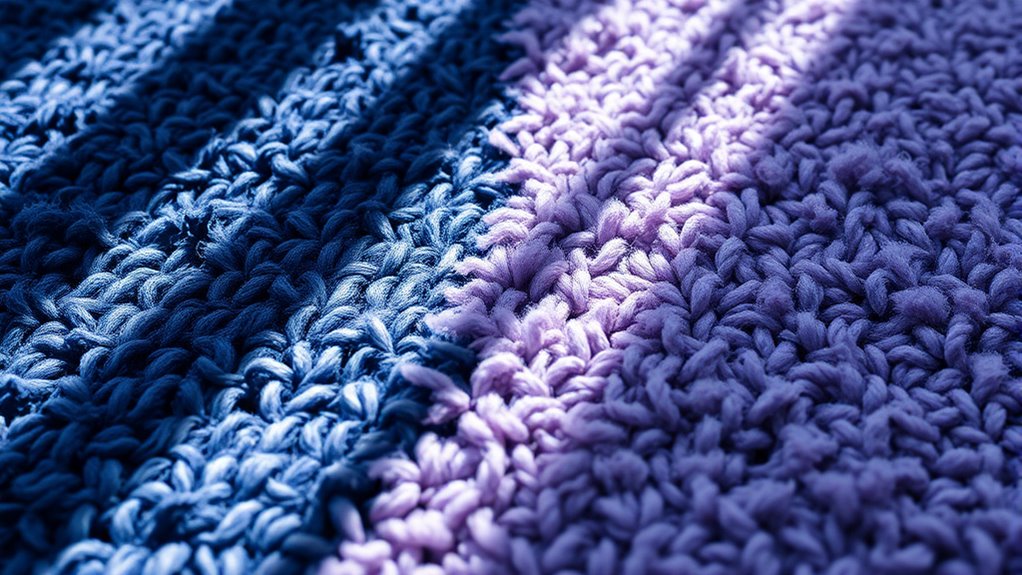
Environmental factors such as sunlight, humidity, and temperature play a crucial role in determining how long the colors in your vegetable-dyed carpets last. Excessive sunlight can accelerate dye migration, causing colors to fade unevenly over time. High humidity encourages mold growth and weakens fibers, leading to faster fiber degradation and loss of vibrancy. Extreme temperatures can also affect dye stability, making colors dull or causing fibers to become brittle. Proper environmental control minimizes these effects, helping your carpet retain its original hues longer. Additionally, stable conditions slow down dye migration, preventing colors from bleeding or fading prematurely. By understanding and managing these factors, you can markedly extend the color longevity of your vegetable-dyed carpet and preserve its natural beauty for years to come.
Myths About Sunlight Exposure and Carpet Lifespan
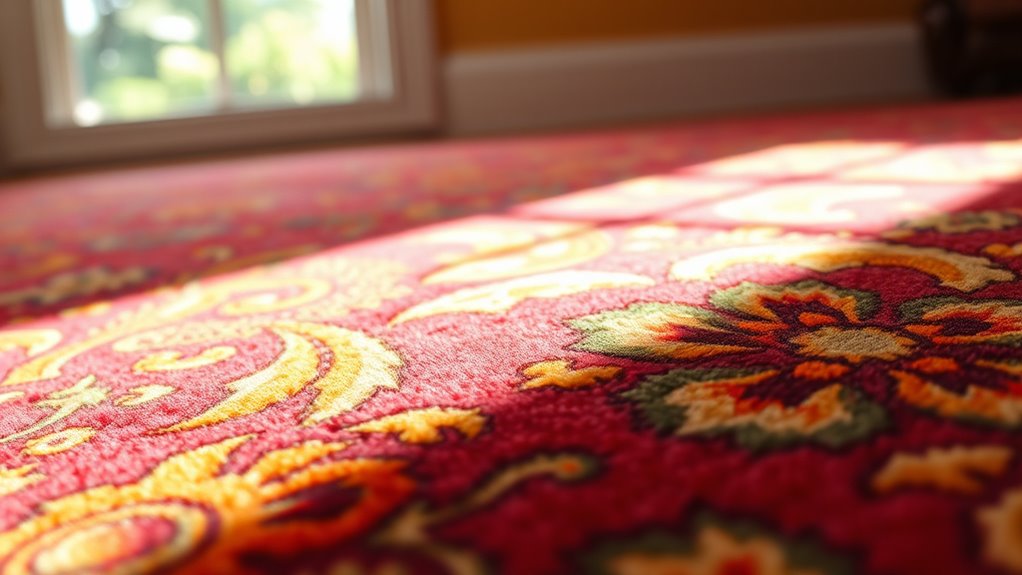
Many people believe that sunlight exposure will inevitably ruin their vegetable-dyed carpets, but this isn’t entirely true. These sunlight myths and UV misconceptions often lead to unnecessary fears. In reality, moderate and controlled sunlight can sometimes help preserve your rug’s beauty. To visualize, consider:
- Sunlight fading carpets unevenly, creating a unique patina
- UV rays causing minimal damage if exposure is limited
- Bright sunlight enhancing the natural hues of vegetable dyes
- Overexposure leading to faster fading, but not immediate destruction
- Proper placement reducing UV impact without hiding your rug
Understanding these UV misconceptions helps you better care for your carpets. Sunlight isn’t always the enemy; it’s the duration and intensity that matter. With proper knowledge, you can enjoy your rug’s beauty without unwarranted fears.
Best Practices for Preserving the Beauty of Vegetable-Dyed Rugs
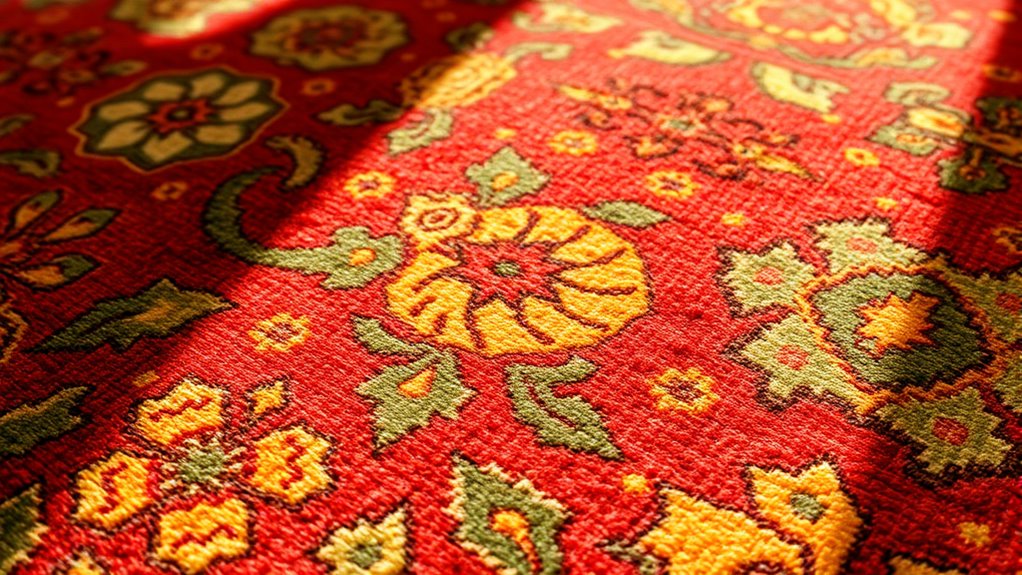
To keep your vegetable-dyed rugs looking vibrant, it’s essential to follow some practical preservation tips. First, limit direct sunlight exposure to prevent UV damage, which can weaken dye stability over time. Use UV-protective window treatments like curtains or blinds to shield your rug without sacrificing natural light. Regularly rotate the rug to ensure even exposure and minimize fading in specific areas. Keep your rug clean by vacuuming gently and avoiding harsh chemicals, which can compromise dye integrity. When cleaning, always use pH-neutral solutions and test a small area first. Proper placement and protective pads beneath furniture help prevent wear and color loss. By implementing these practices, you’ll preserve your rug’s beauty and maintain its vibrant, vegetable-dyed hues for years to come.
Frequently Asked Questions
Do All Vegetable Dyes Fade Equally Under UV Exposure?
Not all vegetable dyes fade equally under UV exposure because dye stability and UV resistance vary. Some vegetable dyes have better UV resistance, making them less prone to fading, while others are more delicate and fade quickly. You should consider the specific dye type and its inherent dye stability when evaluating how it will respond to sunlight. Proper protective treatments can also enhance UV resistance and prolong the vibrancy of vegetable-dyed carpets.
Can Indoor Lighting Cause Vegetable Dyes to Fade?
Did you know that indoor lighting can cause vegetable dyes to fade over time? About 80% of indoor lighting, especially if it includes UV or strong incandescent bulbs, can impact dye stability. You might not notice the fading at first, but prolonged exposure gradually dulls the colors. To protect your vegetable-dyed carpets, keep them out of direct sunlight and use lighting that minimizes UV emissions.
Are Modern Vegetable Dyes More Uv-Resistant Than Traditional Ones?
Modern vegetable dyes are generally more UV-resistant than traditional ones because of advancements in dyeing technology. While natural dyes often fade faster than synthetic dyes, improvements now enhance their durability. When choosing between natural vs synthetic dyes, consider environmental impact; natural dyes are eco-friendly but may need special care. These innovations help preserve vibrant colors longer, reducing the need for frequent replacements and supporting sustainable choices.
How Does Cleaning Affect the Color Longevity of Vegetable-Dyed Carpets?
Think cleaning won’t affect your vibrant vegetable-dyed carpet? Think again. Surprisingly, improper cleaning can accelerate color fading, impacting color preservation more than sunlight. Harsh chemicals or excessive scrubbing break down the dyes, making your beautiful hues dull faster. To keep your carpet’s colors vivid, use gentle cleaners and avoid over-washing. Proper cleaning actually helps maintain its beauty, proving that even in preservation, a gentle touch is key.
Is There a Difference in Fading Between Hand-Woven and Machine-Made Vegetable-Dyed Rugs?
You’ll notice that hand-woven craftsmanship often results in richer, more nuanced colors that age gracefully, while machine-made rugs tend to have more uniform dyeing, which may fade more evenly over time. The artisanal process allows for subtle variations, making fading less noticeable. So, if you want longevity and character, a hand-woven vegetable-dyed rug usually outperforms machine-made ones in maintaining vibrant hues.
Conclusion
Don’t fall for the myth that sunlight will turn your beautiful vegetable-dyed carpets into faded ghosts overnight. With proper care and understanding, you can keep their stunning colors vibrant for decades—far longer than you’d ever imagine! Protect them from harsh environmental factors, avoid overexposure, and follow simple tips. Your gorgeous rugs won’t just survive—they’ll thrive, becoming the vibrant centerpiece of your home for generations to come.
